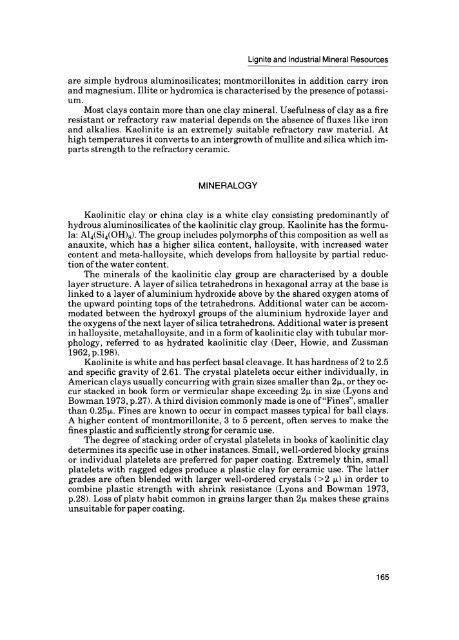Moose River Basin: geology and mineral potential - Geology Ontario
Moose River Basin: geology and mineral potential - Geology Ontario
Moose River Basin: geology and mineral potential - Geology Ontario
Create successful ePaper yourself
Turn your PDF publications into a flip-book with our unique Google optimized e-Paper software.
Lignite <strong>and</strong> Industrial Mineral Resources<br />
are simple hydrous aluminosilicates; montmorillonites in addition carry iron<br />
<strong>and</strong> magnesium. Illite or hydromica is characterised by the presence of potassi<br />
um.<br />
Most clays contain more than one clay <strong>mineral</strong>. Usefulness of clay as a fire<br />
resistant or refractory raw material depends on the absence of fluxes like iron<br />
<strong>and</strong> alkalies. Kaolinite is an extremely suitable refractory raw material. At<br />
high temperatures it converts to an intergrowth of mullite <strong>and</strong> silica which im<br />
parts strength to the refractory ceramic.<br />
MINERALOGY<br />
Kaolinitic clay or china clay is a white clay consisting predominantly of<br />
hydrous aluminosilicates of the kaolinitic clay group. Kaolinite has the formu<br />
la: Al4(Si4(OH) 8). The group includes polymorphs of this composition as well as<br />
anauxite, which has a higher silica content, halloysite, with increased water<br />
content <strong>and</strong> meta-halloysite, which develops from halloysite by partial reduc<br />
tion of the water content.<br />
The <strong>mineral</strong>s of the kaolinitic clay group are characterised by a double<br />
layer structure. A layer of silica tetrahedrons in hexagonal array at the base is<br />
linked to a layer of aluminium hydroxide above by the shared oxygen atoms of<br />
the upward pointing tops of the tetrahedrons. Additional water can be accom<br />
modated between the hydroxyl groups of the aluminium hydroxide layer <strong>and</strong><br />
the oxygens of the next layer of silica tetrahedrons. Additional water is present<br />
in halloysite, metahalloysite, <strong>and</strong> in a form of kaolinitic clay with tubular mor<br />
phology, referred to as hydrated kaolinitic clay (Deer, Howie, <strong>and</strong> Zussman<br />
1962, p. 198).<br />
Kaolinite is white <strong>and</strong> has perfect basal cleavage. It has hardness of 2 to 2.5<br />
<strong>and</strong> specific gravity of 2.61. The crystal platelets occur either individually, in<br />
American clays usually concurring with grain sizes smaller than 2jx, or they oc<br />
cur stacked in book form or vermicular shape exceeding 2jx in size (Lyons <strong>and</strong><br />
Bowman 1973, p.27). A third division commonly made is one of "Fines", smaller<br />
than 0.25|x. Fines are known to occur in compact masses typical for ball clays.<br />
A higher content of montmorillonite, 3 to 5 percent, often serves to make the<br />
fines plastic <strong>and</strong> sufficiently strong for ceramic use.<br />
The degree of stacking order of crystal platelets in books of kaolinitic clay<br />
determines its specific use in other instances. Small, well-ordered blocky grains<br />
or individual platelets are preferred for paper coating. Extremely thin, small<br />
platelets with ragged edges produce a plastic clay for ceramic use. The latter<br />
grades are often blended with larger well-ordered crystals ^2 JA) in order to<br />
combine plastic strength with shrink resistance (Lyons <strong>and</strong> Bowman 1973,<br />
p.28). Loss of platy habit common in grains larger than 2fx makes these grains<br />
unsuitable for paper coating.<br />
165

















